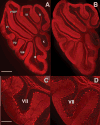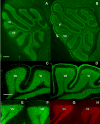Activation of the maternal immune system alters cerebellar development in the offspring - PubMed (original) (raw)
Activation of the maternal immune system alters cerebellar development in the offspring
Limin Shi et al. Brain Behav Immun. 2009 Jan.
Abstract
A common pathological finding in autism is a localized deficit in Purkinje cells (PCs). Cerebellar abnormalities have also been reported in schizophrenia. Using a mouse model that exploits a known risk factor for these disorders, maternal infection, we asked if the offspring of pregnant mice given a mid-gestation respiratory infection have cerebellar pathology resembling that seen in these disorders. We also tested the effects of maternal immune activation in the absence of virus by injection of the synthetic dsRNA, poly(I:C). We infected pregnant mice with influenza on embryonic day 9.5 (E9.5), or injected poly(I:C) i.p. on E12.5, and assessed the linear density of PCs in the cerebellum of adult or postnatal day 11 (P11) offspring. To study granule cell migration, we also injected BrdU on P11. Adult offspring of influenza- or poly(I:C)-exposed mice display a localized deficit in PCs in lobule VII of the cerebellum, as do P11 offspring. Coincident with this are heterotopic PCs, as well as delayed migration of granule cells in lobules VI and VII. The cerebellar pathology observed in the offspring of influenza- or poly(I:C)-exposed mice is strikingly similar to that observed in autism. The poly(I:C) findings indicate that deficits are likely caused by the activation of the maternal immune system. Finally, our data suggest that cerebellar abnormalities occur during embryonic development, and may be an early deficit in autism and schizophrenia.
Figures
Figure 1
Adult offspring of infected mothers display a PC deficit in lobule VII. Calbindin staining of adult cerebella from offspring of control (A, C) and infected mothers (B, D) reveals a deficit in lobule VII in the latter. Panels C and D (bar = 200 μm) are higher magnification views of panels A and B (bar =800 μm).
Figure 2
Young and adult offspring of infected mothers have a PC deficit specifically in lobule VII. (a) Quantification of PC linear density reveals a 33% deficit in lobule VII of the adult offspring of infected mothers, while no difference from controls is found in lobule V. (b) A similar, localized deficit is observed in the P11 offspring of infected mothers (* p < .01).
Figure 3
Heterotopic PCs are found in the offspring of infected mothers. Some P11 (A, bar = 200 μm) and adult (B, bar = 100 μm) offspring of infected mothers display large, calbindin+ cells (white arrowheads and arrow) in the white matter of lobules VI or VII. Such cells are rarely seen in other lobules, or in control cerebella.
Figure 4
Granule cell development is abnormal in the offspring of infected mothers. At P17, control mice lack an EGL (A, C), while a persistent EGL is observed in the offspring of infected mothers (B, D), particularly around lobules VI and VII (arrowhead). In the adult, Nissl staining reveals the normal absence of an EGL in both control (E) and experimental (F) offspring. Moreover, no GABAR α6 staining is found in the ML of the adult control (G) or experimental (H) offspring, indicating that the GCs have completed their migration into the IGL. Scale bars A, B = 200μm; C–H = 100μm.
Figure 5
Purkinje cell loss in the adult offspring of immune-activated mothers is localized to lobule VII. A single poly(I:C) injection in pregnant mice causes a deficit in PC density in the adult offspring, specifically in lobule VII. (* p < 0.02)
Similar articles
- Maternal immune activation produces cerebellar hyperplasia and alterations in motor and social behaviors in male and female mice.
Aavani T, Rana SA, Hawkes R, Pittman QJ. Aavani T, et al. Cerebellum. 2015 Oct;14(5):491-505. doi: 10.1007/s12311-015-0669-5. Cerebellum. 2015. PMID: 25863812 - Prenatal exposure to sodium valproate alters androgen receptor expression in the developing cerebellum in a region and age specific manner in male and female rats.
Perez-Pouchoulen M, Miquel M, Saft P, Brug B, Toledo R, Hernandez ME, Manzo J. Perez-Pouchoulen M, et al. Int J Dev Neurosci. 2016 Oct;53:46-52. doi: 10.1016/j.ijdevneu.2016.07.001. Epub 2016 Jul 14. Int J Dev Neurosci. 2016. PMID: 27423376 - Maternal immune activation differentially impacts mature and adult-born hippocampal neurons in male mice.
Zhang Z, van Praag H. Zhang Z, et al. Brain Behav Immun. 2015 Mar;45:60-70. doi: 10.1016/j.bbi.2014.10.010. Epub 2014 Oct 23. Brain Behav Immun. 2015. PMID: 25449671 - Adult brain and behavioral pathological markers of prenatal immune challenge during early/middle and late fetal development in mice.
Meyer U, Nyffeler M, Yee BK, Knuesel I, Feldon J. Meyer U, et al. Brain Behav Immun. 2008 May;22(4):469-86. doi: 10.1016/j.bbi.2007.09.012. Epub 2007 Nov 26. Brain Behav Immun. 2008. PMID: 18023140 - Maternal Influenza and Offspring Neurodevelopment.
Egorova M, Egorov V, Zabrodskaya Y. Egorova M, et al. Curr Issues Mol Biol. 2024 Jan 2;46(1):355-366. doi: 10.3390/cimb46010023. Curr Issues Mol Biol. 2024. PMID: 38248325 Free PMC article. Review.
Cited by
- Impact of SARS-CoV-2 infection during pregnancy on the placenta and fetus.
Li A, Schwartz DA, Vo A, VanAbel R, Coler C, Li E, Lukman B, Del Rosario B, Vong A, Li M, Adams Waldorf KM. Li A, et al. Semin Perinatol. 2024 Jun;48(4):151919. doi: 10.1016/j.semperi.2024.151919. Epub 2024 Jun 6. Semin Perinatol. 2024. PMID: 38897829 Review. - Juvenile peripheral LPS exposure overrides female resilience to prenatal VPA effects on adult sociability in mice.
Seiffe A, Kazlauskas N, Campolongo M, Depino AM. Seiffe A, et al. Sci Rep. 2024 May 19;14(1):11435. doi: 10.1038/s41598-024-62217-6. Sci Rep. 2024. PMID: 38763939 Free PMC article. - Developmental Ethanol Exposure Impacts Purkinje Cells but Not Microglia in the Young Adult Cerebellum.
Cealie MY, Douglas JC, Swan HK, Vonkaenel ED, McCall MN, Drew PD, Majewska AK. Cealie MY, et al. Cells. 2024 Feb 23;13(5):386. doi: 10.3390/cells13050386. Cells. 2024. PMID: 38474350 Free PMC article. - The association between maternal infection and intellectual disability in children: A systematic review and meta-analysis.
Rezaeinejad M, Riahi SM, Moghadam KB, Tadi MJ, Geraili Z, Parsa H, Marhoommirzabak E, Nourollahpour Shiadeh M, Khatir AA. Rezaeinejad M, et al. PLoS One. 2023 Oct 5;18(10):e0292226. doi: 10.1371/journal.pone.0292226. eCollection 2023. PLoS One. 2023. PMID: 37796792 Free PMC article. - Interaction of the pre- and postnatal environment in the maternal immune activation model.
Gundacker A, Cuenca Rico L, Stoehrmann P, Tillmann KE, Weber-Stadlbauer U, Pollak DD. Gundacker A, et al. Discov Ment Health. 2023;3(1):15. doi: 10.1007/s44192-023-00042-5. Epub 2023 Aug 22. Discov Ment Health. 2023. PMID: 37622027 Free PMC article. Review.
References
- Akshoomoff N, Lord C, Lincoln A, Courchesne R, Carper R, Townsend J, Courchesne E. Outcome classification of preschool children with autism spectrum disorders using MRI brain measures. Journal of the American Academy Child and Adolescent Psychiatry. 2004;43:349–357. - PubMed
- Allen G. Cerebellar contributions to autism spectrum disorders. Clinical Neuroscience Research. 2006;6:195–207.
- Allen G, Courchesne E. Differential effects of developmental cerebellar abnormality on cognitive and motor functions in the cerebellum: an fMRI study of autism. American Journal of Psychiatry. 2003;160:262–273. - PubMed
- Armstrong C, Hawkes R. Selective Purkinje cell ectopia in the cerebellum of the weaver mouse. Journal of Comparative Neurology. 2001;439:151–161. - PubMed
- Borrell J, Vela JM, Arevalo-Martin A, Molina-Holgado ECG. Prenatal immune challenge disrupts sensorimotor gating in adult rats. Implications for the etiopathogenesis of schizophrenia. Neuropsychopharmacology. 2002;26:204–215. - PubMed
Publication types
MeSH terms
Substances
LinkOut - more resources
Full Text Sources
Other Literature Sources
Medical




